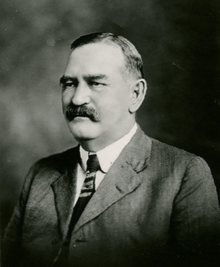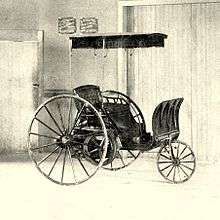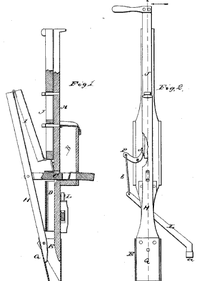John William Lambert
| John William Lambert | |
|---|---|
 | |
| Born |
January 29, 1860 Mechanicsburg, Ohio |
| Died |
May 20, 1952 (aged 92) Anderson, Indiana |
| Resting place | East Maplewood Cemetery |
| Nationality | American |
| Occupation | Mechanical Engineer |
| Known for | America's First Successful Gasoline Automobile and the Father of the Gradual Transmission |
| Spouse(s) |
Mary (Minnie) F. Kelley married 1885 |
| Children | Alvin Ray and Ethel Mae |
| Parent(s) |
George Lambert Anna Lambert parents from Pennsylvania |
John William Lambert (January 29, 1860 – May 20, 1952) was an American automotive pioneer, inventor, automobile manufacturer, and the inventor of the first American gasoline automobile.[1]
Biography
Lambert was born on January 29, 1860, in Champaign County, Ohio[2] on a farm near Mechanicsburg, Ohio. As a teenager Lambert moved with his family to Hillgrove in Darke County, Ohio near Union City. At the age of 16 Lambert devised a clever handheld corn planter that the Lamberts sold nationwide. It revolutionized farming for a brief time, before larger machines were developed. This first successful product started the long career of John Lambert invented items his family manufactured and sold.[3]
One day his father had promised to take him to a tannery the next day to see an engine that could run without a steam boiler. This tannery was located in Greenville, Ohio that his father had previously seen. When they arrived at the tannery the next morning, Lambert was disappointed to find that the building had burned to the ground the night before. He searched amongst the ashes and found the burned Otto gas engine. This was the only one he had ever heard of or seen. He took it apart to see how it was constructed. It was a slide valve coal gas engine.[4]
In 1885 Lambert moved to Ohio City, Ohio, previously known as Enterprise, in Van Wert County. There he had an agricultural implement store, a grain elevator, and a lumber yard. Lambert also owned the town's opera house, town hall, jail and other town properties.[5] Lambert always kept in the back of his mind the gas engine he saw in 1876. One day in the 1880s he heard of Karl Benz building an automobile in Germany and it rekindled his vision to build a gasoline engine that would operate a "horseless carriage."[6]
Stationary gasoline engines were extremely heavy in those days and too much for a "horseless carriage." It so happened that a John B. Hicks had made a patent application in 1890 on a stationary gasoline engine. Lambert contacted Hicks and through Hicks was introduced to a Mr. Wacholtz, a German engineer who had worked with Hicks. On December 20, 1890 Wacholtz made a contract with Lambert to make a lightweight automobile engine. The license granted to Lambert a shop right or license to manufacture gas engines embodying the improvements invented by the said Hicks as above stated for the use only on land vehicles other than railway or tramway cars.[6]
Benz's automobile was belt driven from an engine. Lambert felt if he could make a lightweight gasoline engine that did not operate with belts to propel it he would have a valuable transportation vehicle that could be utilized in the United States. Lambert hired Wacholtz to work with him on building a balanced motor containing three cylinders. He agreed to pay for all the expenses of the development of such an engine. The machine was done by Lowell Machine Works of Cleveland, Ohio. One of the reasons the engine was fabricated in Cleveland was because they had gasoline available there. He also had the design and the body of "horseless carriage" done there. Also the running gears for the automobile were fabricated there. Lambert went to extremes to have the engine made lightweight. This was the first experience Lambert had with building an automobile engine. He originally agreed to spend $200 for the machine work to produce the automobile engine, however after spending $3,300 Wacholtz was not able to produce a working engine in Cleveland.[6]
Lambert stopped the work at this stage of fabrication and shipped the non-working engine and incomplete automobile to a small machine shop that he owned in Ohio City. This way he could then devote his personal attention to the engine and automobile when he could from his businesses he was running there. The automobile consisted of two clutches and two chains, which were connected to a jack shaft. The two clutches gave two speeds forward and there was no reverse speed used. The single front wheel of the tricycle designed automobile was steered by a foot lever and a hand lever. This direct steering method provided that the arms could be rested and the steering done by the feet, and vice versa. One item that needed to be solved for completion and a working engine was a means of carburation. Lambert heard of a means of vaporizing gasoline by Gottlieb Daimler of Germany. He went to New York to see the engine that was operating a boat. After seeing this complicated carburetor Lambert developed what he called the "vaporizer." This was a simpler carburetor than Daimler's, which he was then able to get the engine working the way he intended it to. The automobile was completed soon after he had it Ohio City.[6]

There was a great deal of secrecy surrounding the developments of Lambert's automobile. Operational tests were conducted with the window blinds pulled at the farm implement showroom where he ran it. Outside road tests were conducted at night on roads that were not used. That was a good thing since many times there were long intervals between being able to get the automobile started again after it stopped. It turned out that the villagers didn't even know what Lambert was working on since it was such a new concept. They didn't realize the significance of Lambert's horseless carriage.[6] Lambert is said to have had the first automobile accident. One time when he was testing his "horseless carriage" at night in a secret run he drove his vehicle into a tree stump and ran into a hitching post.
He made up sales brochures for his "horseless carriage" in January 1891, however not a single person bought one. He decided after extensive work on this automobile that the idea of a "horseless carriage" was way off into the future and was discouraged to continue. His father and brother encouraged him to sell his businesses in Ohio City and move to Union City, Ohio where they were and made stationary gasoline engines – which had an established market already.[6] There in 1892 he started the Buckeye Manufacturing Company and the Lambert Gas and Gasoline Engine Company to make stationary engines and farm machinery implements.[6] Later in 1893 Lambert started the Union Automobile Company in that city. Lambert moved to Anderson, Indiana from Union City in 1893. He then moved some of his machinery from his Union City plant at that time. Lambert incorporated the Buckeye Manufacturing Company and Lambert Gas and Gasoline Engine Company that year.[2]

patent 178,166
Family
The United States census shows Lambert was living in Jackson Township, Darke County, Ohio in 1880. It shows he was twenty years old and the third born in the family. His siblings were Anna Elizabeth (24), George Albert (22), Savina Ellen (deceased), Emma M. Lambert (17), Harry C. Lambert (14), Mary I. Lambert (12), Frank W. Lambert (10), Samuel W. Lambert (8), and Levi C. Lambert (6).[7] Many of his brothers as well as his parents would later form various companies with Lambert, with the original company usually named a Lambert Company and later changed to another company name.
Innovations
- Held about 600 patents in his career.[8]
- Patented a friction transmission which was a gearless transmission.[9]
- Patented his first gasoline engine in 1887, the first in the United States.[10][11]
- Built America's first successful automobile in 1891[12]
- Registered his first patent in 1876 when he was sixteen, on a corn seeder that sowed 3 grains at once, .[8]
Festival
Lambert Days[13] is a community celebration that honors the life of John W. Lambert, the first gasoline-powered single-cylinder vehicle, and the world's first car wreck. This is an annual three-day event that takes place in Ohio City, Ohio on the third weekend of July. Activities and events: Car Show, Art Festival, Flea Market, Sporting Events, Parade, Live Entertainment, and Lambert Automobile Displays. https://www.lambertdays.com
See also
- Union automobile
- Lambert automobile
- Buckeye gasoline buggy
- Union Automobile Company
- Lambert Automobile Company
- Buckeye Manufacturing Company
- Lambert friction gearing disk drive transmission
- Lambert-Parent House
References
- ↑ Anderson Daily Bulletin, Front page and page 6, Wednesday May 21, 1952 obituary: "Services to be held Tomorrow", Mr. Lambert was the inventor of the gasoline automobile and for many years was a prominent manufacturer of gasoline engines.
- 1 2 Forkner, p. 385
- ↑ Lambert, Carol Jean, Something New Under the Sun, Merrimack Media, Cambridge, MA. 2014 ISBN 9781939166319
- ↑ Dolnar, vol.10, Jan. 1906, p. 225
- ↑ Kimes, p. 835
- 1 2 3 4 5 6 7 John W. Lambert biography
- ↑ 1880 Census: Jackson, Darke, Ohio; Roll:T9_1011; Family History Film: 1255011; Page: 418.2000; Enumeration District:76; Image: 0218.
- 1 2 Indianapolis Star, May 21, 1952, p. 10; Anderson Daily Bulletin, May 21, 1952, p.1, obituary.
- ↑ Indianapolis Star, March 22, 1914, p.18.
- ↑ Anderson Daily Bulletin, May 21, 1952, pp. 1 and 6, obituary
- ↑ Indianapolis Star, May 21, 1952, p. 10.
- ↑ "John W. Lambert built one of America's first successful automobiles in 1891". Retrieved 2008-12-19.; Encyclopædia Britannica cites Antique Automobile magazine.
- ↑ Bigham, Scott. "Lambert Days". Ohio City Park Board. Facebook. Retrieved 22 February 2013.
Bibliography
Main sources
- Biography of John W. Lambert, written by his son January 25, 1935 — obtained from the Detroit Public Library, National Automotive History Collection
- Brandon, Rodney H., Who is Who in Anderson, published privately in 1906
- Dolnar, Hugh. "The Lambert, 1906 Line of Automobiles" in Automobile Trade Journal, v.10. Chilton Company, January 1906
- Forkner, John L. History of Madison County, Indiana, New York and Chicago, The Lewis Publishing Company, 1914
- The Horseless Age: The Automobile Trade Magazine. The Horseless Age Company, 1902
- Lambert, Carol Jean. Something New Under the Sun. Merrimack Media, Cambridge, MA. 2014. ISBN 9781939166319
Secondary sources
- Bailey, L. Scott. "Historic Discovery: 1891 Lambert, New Claim for America's First Car". Antique Automobile magazine, Vol. 24, No. 5, Oct–Nov 1960
- Wise, David Burgess. The New Illustrated Encyclopedia of Automobiles. ISBN 0-7858-1106-0
- Dittlinger, Esther et al. Anderson: A Pictorial History. G. Bradley Publishing, 1990, ISBN 0-943963-16-8
- Encyclopædia Britannica, Vol. 2. Chicago, Encyclopædia Britannica Inc., 1968
- Georgano, G. N., The Beaulieu Encyclopedia of the Automobile, Taylor & Francis, 2000, ISBN 1-57958-293-1
- Huffman, Wallace Spencer. "Indiana's Place in Automobile History" in Indiana History Bulletin, vol 44, no. 2, Feb. 1967; Indianapolis, Indiana Historical Bureau
- Huhti, Thomas. The Great Indiana Touring Book: 20 Spectacular Auto Tours. Big Earth Publishing, 2002, ISBN 1-931599-09-2
- James, Wanda. Driving from Japan. McFarland, 2005, ISBN 0-7864-1734-X
- Kimes, Beverly Rae. Standard Catalog of American Cars, 1805-1942. Krause Publications, 1996, ISBN 0-87341-428-4
- Lambert, Carol Jean. Who Invented America's Gasoline Automobile?. Merrimack Media, 2013, ISBN 9781939166296
- Madden, W. C., Haynes-Apperson and America's First Practical Automobile: A History, McFarland, 2003, ISBN 0-7864-1397-2
- Scharchburg, Richard P. Carriages Without Horses: J. Frank Duryea and the Birth of the American Automobile Industry. SAE, 1993, ISBN 1-56091-380-0